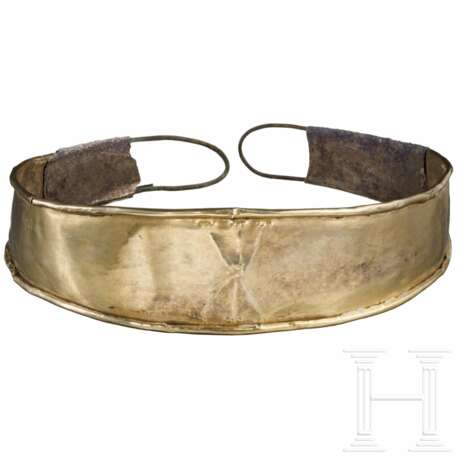Diadem aus Elektron- und Silberblech, Kupferzeit Anatoliens, 2. Hälfte 3. Jtsd. v. Chr.
19.11.2024 10:00UTC +01:00
Classic
Starting price
8500EUR € 8 500
| Auctioneer | Hermann Historica |
|---|---|
| Event location | Germany, Grasbrunn / München |
| Buyer Premium | 25 % |
Archive
The auction is completed. No bids can be placed anymore.

ID 1323247
Lot 4036 | Diadem aus Elektron- und Silberblech, Kupferzeit Anatoliens, 2. Hälfte 3. Jtsd. v. Chr.
Blechdiadem aus natürlich vorkommender Elektron-Legierung (ca. 8 Karat Gold). Das sich zu beiden Enden hin von 4,8 auf 2,5 cm verjüngende Blechband ist an Ober- und Unterkante von hinten her nach vorne um einen Bronzedraht gebörtelt, sodass ein wulstiger Rand die glatte Fläche dazwischen begrenzt. Direkt in der Mitte des Diadems ist auf der Stirnseite ein Muster von hinten her mit Punzen eingedrückt: ein "Andreaskreuz" über einem senkrechten "Mittelstab". Der Kreuzungspunkt der Linien ist mit einem Kreis aus Punktpunzen markiert.
An den oberen und unteren Enden der Linien befinden sich je drei horizontal angeordnete Punktpunzen. An den Enden des Diadems endet das Elektronblech und wird durch Silberbleche verlängert, die gleichermaßen um den Bronzedraht gebörtelt und vorne zusätzlich mit einem Silberniet auf dem Elektronband befestigt sind. Der Bronzedraht, auf dem die Bleche umgebörtelt sind, liegt am hintersten Ende frei und bildet jeweils eine Schlaufe, sodass das Diadem mit einem Band aus organischem Material größenverstellbar geschlossen und getragen werden konnte. Diademe solcher Art aus Edelmetall sind u.a. aus fürstlichen Bestattungen kupferzeitlicher Herrschernekropolen (z.B. Alaca Hüyük) bekannt geworden. Länge im gebogenen Zustand ca. 20 cm, Breite ca. 18 cm, maximale Breite an der Stirn 4,8 cm. Gewicht 143,40 g.
Provenienz: Aus rheinischer Privatsammlung, erworben Anfang der 90er Jahre im Kölner Kunsthandel.
A diadem made of electron plate and sheet silver, Copper Age of Anatolia, 2nd half of the 3rd millennium B.C.
A diadem made of electron plate and sheet silver, Copper Age of Anatolia, 2nd half of the 3rd millennium B.C.
Sheet metal diadem made from naturally occurring electron alloy (approx. 8 carat gold). The sheet metal band tapers from 4.8 to 2.5 cm at both ends and is curled around a bronze wire at the top and bottom edges from the back to the front, so that a bulging edge borders the smooth surface in between. Directly in the centre of the diadem, a pattern is embossed with punches on the front from behind: a "St Andrew's cross" over a vertical "centre bar". The intersection of the lines is marked with a circle of punches.
At the upper and lower ends of the lines there are three horizontally arranged dot punches. The electron plate finishes at the ends of the diadem and is extended by silver plates, which are also bent around the bronze wire and additionally attached to the electron band with a silver rivet. The bronze wire, on which the plates are bent, is exposed at the rear ends and forms a loop on each side so that the tiara could be closed and worn with a band of organic material to adjust its size. Similar diadems made of precious metal are documented from royal burials in Copper Age rulers' necropolises (e.g. Alaca Hüyük). Length when bent approx. 20 cm, width approx. 18 cm, maximum width at the forehead 4.8 cm. Weight 143.40 g.
Provenance: Rhenish private collection, acquired in the early 1990s in the Cologne art trade.
Condition: II
| Auction house category: | Egypt and Asia |
|---|
| Auction house category: | Egypt and Asia |
|---|
| Address of auction |
Hermann Historica Bretonischer Ring 3 85630 Grasbrunn / München Germany | ||||||||||||||
|---|---|---|---|---|---|---|---|---|---|---|---|---|---|---|---|
| Preview | |||||||||||||||
| Phone | +49 (0)89 5472 649 0 | ||||||||||||||
| Fax | +49 (0)89 5472 64999 | ||||||||||||||
| Buyer Premium | 25 % | ||||||||||||||
| Conditions of purchase | Conditions of purchase | ||||||||||||||
| Business hours | Business hours
|


